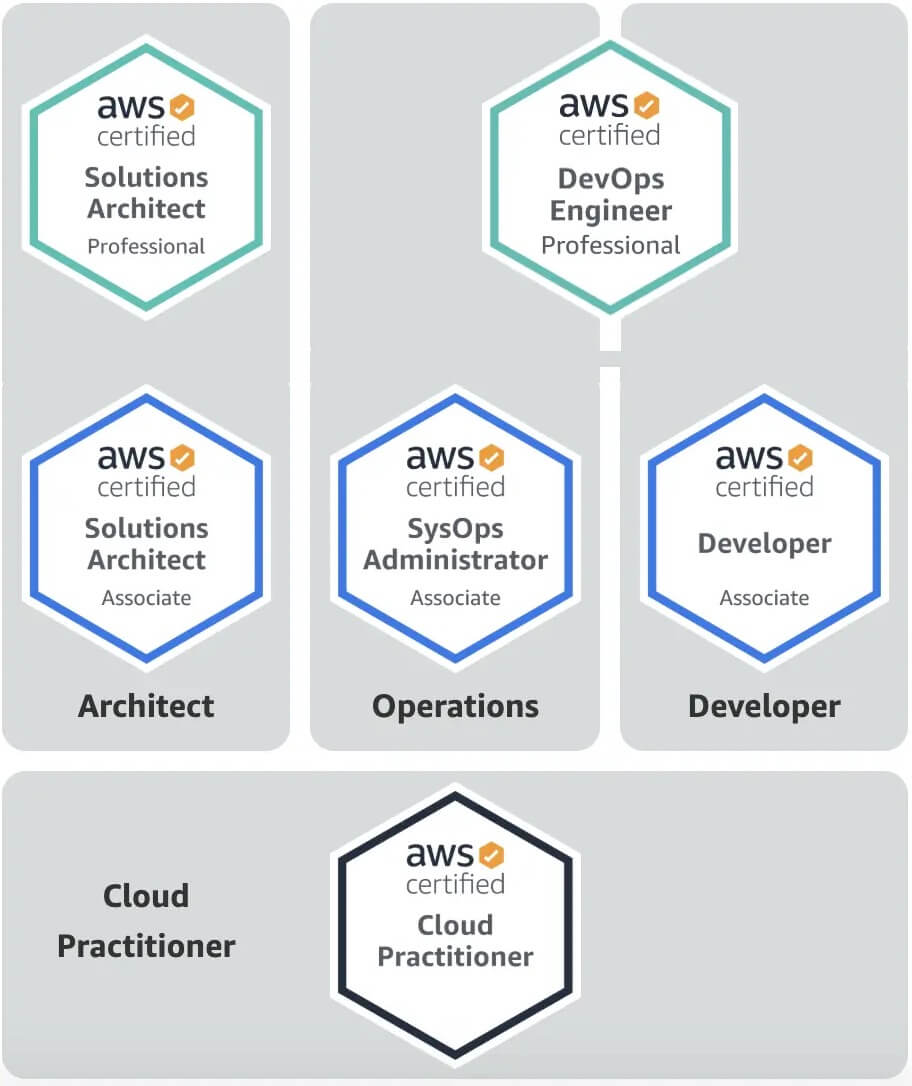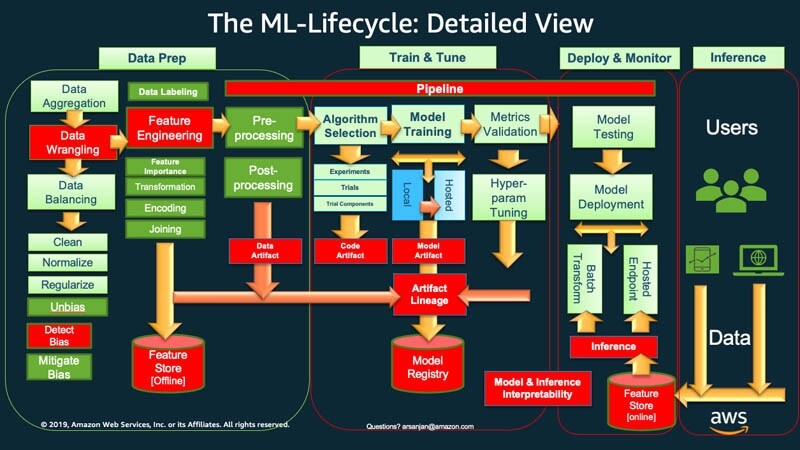Kickstart Your Cloud Journey with These 12 AWS Certifications
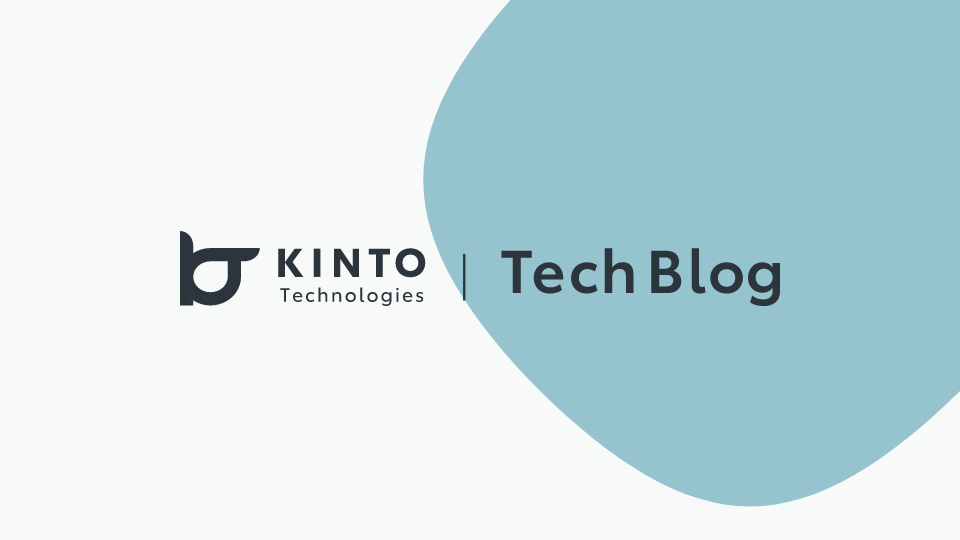
1. Starting Point: Overview
Nice to meet you! I'm YOU, an infrastructure architect in the Cloud Infrastructure Group at KINTO Technologies.
I joined the company this January, and this is my first post on the Tech Blog. I’m excited to share more in the future! I started my AWS certifications with SAA in October 2023 and completed MLA in February 2025, achieving all 12 AWS certifications in 1 year and 4 months. I'd like to take this opportunity to share my personal thoughts and information I picked up while working toward the 12 certifications.
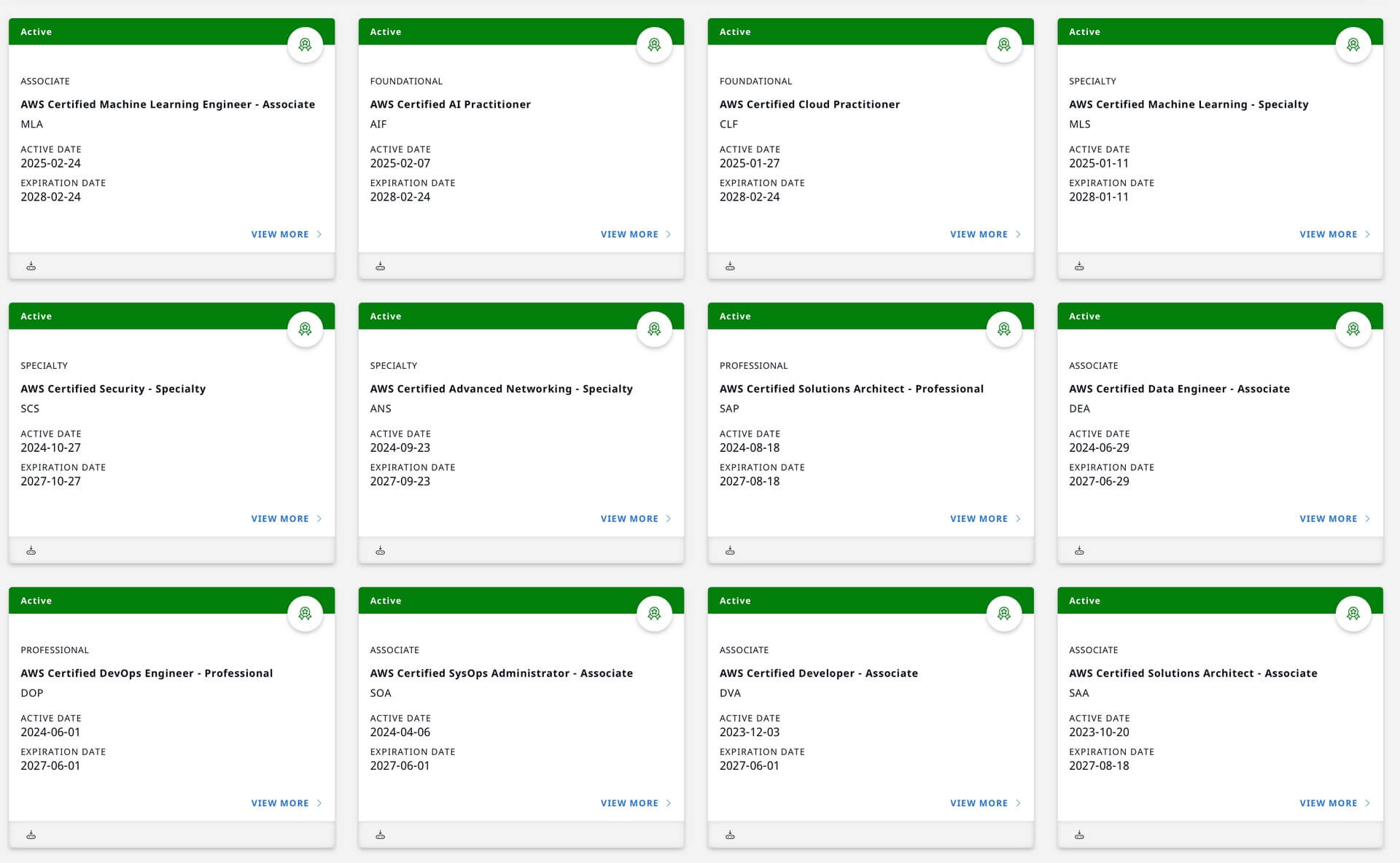
First off, by "12 AWS certifications," I mean every certification that AWS currently offers. The criteria are revised annually
and announced in advance on the AWS Japan APN Blog, where selected individuals are also recognized. In 2024, only 1,222 individuals were officially recognized as "AWS All Certifications Engineers." According to the official article,
"earning and maintaining all AWS certifications" demonstrates a solid understanding of AWS technologies and the ability to offer customers reliable and up-to-date technical guidance.
While there are many companies offering cloud services—like Azure and GCP—AWS stands out as the industry standard. That's thanks to its sheer volume and quality of services, unmatched pace of updates, and the flexibility that comes from its leading market share.
With the growing spotlight on AI, the importance of cloud technology is also rising. Some people might think, "Cloud or AI? That has nothing to do with me." But just like how using a computer has become second nature in most jobs, it won't be long before using AI in everyday life becomes just as common.
The cloud provides easy access to both AI models and the computing power required to run them, making cloud technology essential to staying current in today's landscape. So, why is getting certified important when learning AWS and the cloud?
That's exactly what I'll explain next.
2. Current Status: Where I Stand
Unfortunately, having a certification doesn't necessarily make a big difference in how well you can use the cloud. To give an example, let's treat "cloud" like learning English. Say you studied hard for the TOEIC and got a high score in hopes of using English more effectively. But do you think that alone means you've really improved your English?
No matter how good you are at test strategies, or how many words and grammar rules you memorize, it doesn't mean much if you can't actually use English when it counts. That said, it's definitely wrong to say TOEIC isn't helpful for improving your English skills. If it had no value, there's no way so many universities and companies would use TOEIC scores as a benchmark. TOEIC is a test that quantifies business English skills, which is why the score is recognized as a reflection of ability, not just a number.
In the same way, having all 12 AWS certifications sets a clear benchmark in the cloud field. It turns abstract knowledge into something visible and concrete in the form of a qualification. Here's a breakdown of the benefits that come from this kind of visualization:
- Clear goal setting: since the certifications follow a roadmap provided by AWS, you can plan your learning step by step.
- Motivation: setting an exam date gives you a clear deadline, which helps create an environment where you can stay focused and motivated.
- Knowledge assurance: you'll gain and confirm the minimum level of knowledge needed to pass the exam.
- Review: even for those already familiar with the cloud, it's a good opportunity to review and check what's required for certification.
- Discovery: because the exams evolve with updates, they give you chances to learn about areas you might not normally encounter.
Even if you switch the wording to another language, doesn't the content still come across naturally and make sense? In the end, it's not just about getting certified to boost your cloud skills, or getting certified because you want to work with the cloud. What really matters is the value in the learning process itself.
The future of AWS certification
Next, I'd like to dig into something I felt over the past year or so while preparing for AWS certification: "Where is AWS certification headed from here?"
When I first started studying for AWS certification back in 2022, ChatGPT was taking off, and interest in AI was growing rapidly. In response, AWS began rolling out more and more AI-focused services, and from 2024, they made some big changes to their certification structure.
In April 2024, three existing Specialty certifications were discontinued:
AWS Certified Data Analytics – Specialty (DAS)
AWS Certified Database – Specialty (DBS)
AWS Certified: SAP on AWS – Specialty (PAS)
To replace DAS and DBS, a new certification was introduced in March 2024:
AWS Certified Data Engineer – Associate (DEA)
Later, in October 2024, AWS introduced two more certifications to reflect the roadmap for new AI services like Amazon Q and Amazon Bedrock, along with enhancements to existing services like Amazon Sagemaker:
AWS Certified AI Practitioner (AIF)
AWS Certified Machine Learning Engineer – Associate (MLA)
This was a major shake-up, and honestly, it caused some headaches even for individual learners like me. The content I had been studying was significantly updated, so I had to completely rethink my exam schedule. It's certain that AWS certifications will continue to evolve, especially with AI leading the way as a major tech trend.
While this is purely speculation, the certification that seems most likely to change is:
AWS Certified Machine Learning Engineer – Specialty (MLS)
The MLS was last updated in July 2022, so its content is already outdated compared to the AIF and MLA. It may simply be updated as a Specialty-level certification, but there's a strong chance it will be restructured into a new Professional qualification. Why? Because the current certification path is organized into three tiers: Practitioner, Associate, and Professional.
In the same way, after AIF and MLA qualifications, a Professional-level certification is likely to follow. Whether a specialty certification will be upgraded to a professional level is ultimately up to AWS. But if that does happen, we'll likely need to anticipate a higher-level DEA certification as well.
(Tentative) AWS Certified Machine Learning Engineer – Professional (MLP)
(Tentative) AWS Certified Data Engineer – Professional (DEP)
This is a logical prediction, but it comes with its own problems. AWS seems to uphold a symbolic 12-certification crown structure, so adding two more would break that and push the total beyond 13.
One way to avoid this is to reduce the number of existing specialties—especially those that have become unclear—as new certifications are added.
(For example) AWS Certified Security – Specialty (SCS)
AWS Certified Advanced Networking – Specialty (ANS)
Unlike some of the other specialty certifications that have already been retired, SCS and ANS are built around deeper, professional-level knowledge. Over 60% of the content overlaps with the Professional-level certifications. SCS focuses on organization-wide security, while ANS emphasizes networking with on-premises environments. That said, there are some current shortcomings that can't be ignored.
SCS hasn't been updated to reflect developments in AI, so it doesn't cover AI-related security topics. With AI evolving so quickly, security and compliance around AI are becoming increasingly critical. So the question now is whether to add AI content into SCS, or to spread it across each professional-level certification. I think the second option is more likely, since many specialty certifications have already been merged or discontinued to align with the AI trend. In the case of ANS, it's in a similar position to SCS. Even though networking can support AI, within AWS itself, there's not a big difference in capability. It is true that Azure is required for OpenAI, GCP for Gemini, and a multi-cloud setup is necessary to use AI services provided by other cloud vendors. However, since AWS tends to be less proactive in supporting non-AWS products, there haven't been any updates to multi-cloud-related certifications so far. On the other hand, due to the growing anti-cloud sentiment, hybrid cloud is gaining attention, so the ANS certification system is likely to remain.
In any case, reducing the number of certifications helps maintain the 12-certification status, so that's one possible approach. Another is consolidating roles, such as DevOps Engineer, instead of introducing new professional-level certifications.
(Tentative) AWS Certified MLOps Engineer – Professional (MOP)
AWS describes MLOps as "an ML culture and practice that unifies ML application development (Dev) with ML system deployment and operations (Ops)."
This refers to the entire process involved in machine learning. By going through the data engineering and data analysis handled in DEA, you can make use of the entire machine learning flow used in AIF, MLA, and MLS. So if you were to choose just one area to develop as a new professional skill, I believe this would be a practical and effective path.
Question Types of AWS Certifications
It's not just the types of certifications that are changing. There are also updates to the exam formats.
Since the SOA lab exam was discontinued, the remaining exams have been evaluated solely through multiple-choice questions. While the advantage is that results can be measured objectively and quantitatively, it's also true that this format sometimes doesn't reflect hands-on implementation skills. AWS seems aware of this, and they've introduced a new question format starting with the AIF and MLA exams.
According to the AIF exam guide, the following types of questions may appear.
- Ordering: has a list of 3–5 responses to complete a specified task. To earn points for the question, you must select the correct answers and place them in the correct order.
- Matching: has a list of responses to match with a list of 3–7 prompts. To get points, you must match all the pairs correctly
- Case study: has one scenario with two or more related questions. The scenario is the same for each question in the case study. Each question in the case study will be evaluated separately and points are awarded for each correct answer.
These three types didn't appear very frequently in my exam, but just as the guide describes, they were included. The difficulty level was similar to that of regular multiple-choice questions. Due to AWS exam confidentiality, I can't share exact question formats, but here's how I'd describe the types based on my experience: For sorting and matching, you can't rely on option similarity to guess the right answer. You really need to know the required steps and how the given terms or descriptions logically connect.
As for case studies, while the format is essentially multiple choice, they bundle several questions into one shared scenario. This format allows you to approach the case from multiple angles, and it also helps avoid situations where you're tested more on reading comprehension than on applying your actual knowledge. In the real world, we don't just answer one question at a time. We usually simulate each case and think through it as a whole. That's why I think the case study format is a great approach for test takers.
When it comes to AWS certifications, the question formats will likely continue to evolve. For example, like the hands-on labs in the SOA exam, we can expect more questions along the lines of, "Can you actually implement this?" These kinds of changes won't happen just once: they'll gradually be introduced into other certifications as well. So, if you're preparing for an AWS exam, it's important to stay up to date and be ready!
3. Mindset: Preparing for the Challenge
This is something I often hear from people around me, regardless of their job title:
"I don't work in anything related to AWS, but will this actually be useful if I study it?" "If I want to get AWS certified, where should I start?" "What are you using to study?"
I'm certified as a cloud engineer, which means I already needed to have the knowledge to work in the cloud. Because I use it in my actual job, I interact with cloud services far more often than most people. That's why getting certified doesn't automatically mean you'll be ready to work in cloud-related roles right away.
If you haven't used the cloud before, it's rare to suddenly become able to use it just because you passed an exam. A certification is kind of like a coupon. Even if you have a coupon that gives you 10% off at a gas station on purchases over 10,000 yen, there are lots of reasons you might not be able to use it: you don't have a car, the station is too far away, or you don't have enough money to hit the discount threshold. Seen this way, the conditions for using the coupon are pretty clear:
- You or someone close to you owns a car or is planning to.
- The gas station that accepts the coupon is within reach.
- You're in a position to make use of the discount.
So before jumping in, check whether you actually have a reason to want that coupon.
In other words, "Are you in a position to take action and make use of the qualification?" Even if you get a coupon, it's not like a car will magically appear, or a gas station will pop up right in front of your house, or the money to use it will suddenly fall into your lap—those things just don't happen in real life, right? The same goes for the cloud and AWS. For those who feel the cloud doesn't really apply to their work, examples might include:
- Business professionals outside of IT
- Developers who don't specialize in infrastructure
- Infrastructure specialists focused solely on on-premises systems
Now, what would you recommend to someone who says they can't afford to buy a car? With car leasing or subscriptions, as long as you can pay the monthly fee, you can still drive a car. That's exactly what the cloud is in IT. I believe that "borrowing technology" is the essence of the cloud. If learning the tech is too expensive, you can just borrow it. Of course, the specifics vary by field, but I truly believe that just understanding this concept can completely change how you view technology.
If someone says, "The gas station's too far," then that's a perfectly valid reason. There's no need to force yourself to go. But what if the station is close enough to swing by on your daily commute? For developers, the cloud isn't really that far away. In fact, just shifting your perspective a little might reveal a whole world of possibilities right next to you.
Finally, no matter how good a coupon you have, it's no use if you don't use it. Even if you already own a car and a gas station opens up right outside your home, you still won't be able to use the coupon if you always stick to your usual station. People may have all kinds of reasons:
maybe they can't pay the 10,000 yen up front, they already have a different gas card, or they're unsure about the store. But the undeniable fact is that infrastructure professionals are more naturally positioned to get into the cloud than anyone else. If you’ve only worked in on-prem environments, the cloud, whether IaaS (Infrastructure as a Service) or PaaS (Platform as a Service), might feel unfamiliar. Still, the fundamentals of the cloud are built on infrastructure knowledge. That's why, compared to people in business or development roles, it's actually much more accessible. So instead of saying, "I don't have the ability to work with the cloud, "how about saying, ‘Let's build the ability to work with the cloud’"?
I started my career in development, but thanks to the cloud knowledge I gained through self-study, I was trusted with cloud-related tasks as well. After that, I earned certifications and was able to transition into a cloud-focused role. Honestly, if I had only stuck to what I was already doing or aiming to do, I probably wouldn't have made it this far. Getting all 12 AWS certifications really feels like it's opened up more doors for me. Since joining KTC, I'd say about 50% of the knowledge I gained from certifications has been directly applicable in practice. As for the other 50%, I'm continuing to work on ways to put it to good use. KTC has set "AI First" as its key goal for this year, and I plan to contribute actively to our AI initiatives.
If you're interested in KTC's AI First direction, I highly recommend checking out the article written by our Vice President, Kageyama.
The official AWS認定パス are also recommended. Please take a look for reference!
4.Strategy: How I Passed the Exam
There are plenty of people out there who recommend different study methods, so instead of repeating the same advice, I'd like to talk about strategies for efficiently tackling AWS certification from a different angle.
The Straightforward Approach
Studying seriously is actually very simple. The key is to start from scratch and work through the content outlined in the previously mentioned AIF exam guide This method is ideal for those who don't have basic knowledge and want to learn properly without rushing, or for anyone who prefers to take their time with exam prep. The process can be broken down into five stages:
-
Information gathering: look through sources like search engines, social media, YouTube, blogs, etc. to find your preferred sources.
-
Choose your source: from the available options, pick the one that fits you best.
-
Official AWS documents: The documentation provided by AWS is always up to date, highly reliable, and of high quality. Even when I'm using other learning methods, I always go back to check the official docs. The AWS Training Center, which offers some content for free, is also a great help—definitely take advantage of it. I haven't used any paid services, but from what I've seen, they have a similar effect to that of external learning website introduced below.
-
YouTube: offers the largest collection of free content, but the quality and accuracy can vary greatly depending on the uploader, and the information isn't always up to date. That said, if you're comfortable learning through video and audio and don't have language barriers, these downsides become less of an issue. It's also great that you can just give it a try and stop anytime you like.
-
Books: If you like analog-style studying, books are a solid choice. Their strength lies in offering focused content with a certain level of quality assurance. The advantage is that you can get a general idea of the contents before buying, and everything you need is typically packed into one volume. However, be aware that books tend to lag behind on updates, so they're not always ideal for something like AWS certification, where things change quickly. Unless you're planning to dive into study right away and take the exam before the certification updates, it may be better to hold off.
-
External learning websites: let's look at paid learning resources, such as external website like Udemy. These are paid resources, but they offer high-quality content and are generally updated faster than YouTube. In short, they combine the strengths of both YouTube and books, which is why I personally use them often. One thing to be careful about AWS certification is that many topics overlap across different certifications, so be sure to check the table of contents carefully before purchasing a course.
-
Start studying: study time varies depending on the exam, but in most cases, planning for about 2 to 3 months worked best for me.
-
Verification: use AWS official mock exams to assess your current level.
-
Exam: be sure to schedule your exam in advance. You can take it either online or at a testing center offline, but I recommend offline for a more stable test environment. If any problems arise during an offline exam, the test center staff can help resolve them, and as a bonus, offline exam results tend to arrive faster too.
Quick-Attack Method
Some people think: "I already know AWS, so I don't need to start from scratch. I just want to focus on the parts I'm unfamiliar with." "I'm fine with learning as I go. Just want to get certified as fast as possible!" I've approached a few exams this way myself, so let me share the most cost-effective strategy I've used.
Keyword Summary
Use AI to summarize service content and extract only the key points you need to know.
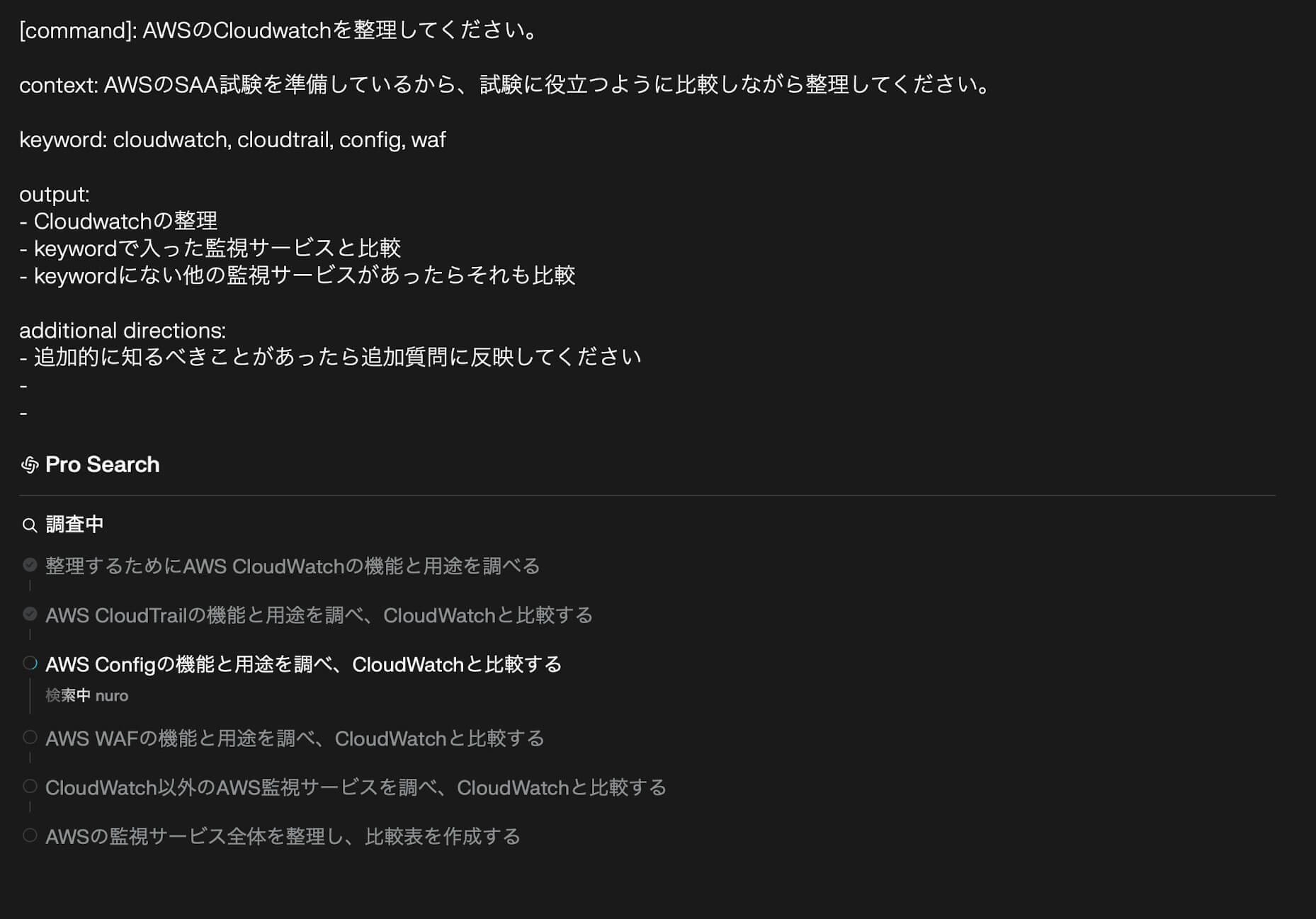
Answer
Here is a summary centered on CloudWatch, AWS's monitoring service, along with a comparison to related services such as CloudTrail, Config, and WAF. I'll also briefly mention a few other monitoring tools not covered in detail here.
About CloudWatch
Overview
Amazon CloudWatch is a service for monitoring AWS resources and applications in real time. It provides the following key features:
-
Metrics collection: collects resource data such as CPU usage, disk I/O, and network traffic.
-
Log monitoring: collects and analyzes application and system logs.
-
Alarm settings: sends notifications or triggers automated actions based on defined thresholds.
-
Event management: automates responses to specific events (e.g., sending notifications when an instance is launched).
Major use cases
-
Monitoring resource performance
-
Detecting anomalies and sending alert notifications
-
Visualizing the overall system operation status
Comparison between CloudWatch and its related services
| Service name | Main objective | Features | Major use cases |
|---|---|---|---|
| CloudWatch | Metrics & log monitoring | Monitor AWS resources and applications in real time. Receive near real-time notifications. |
Resource monitoring, performance optimization, and anomaly detection. |
| CloudTrail | Recording operation history | Record who did what and when (API calls). For compliance and security audits. |
Security audits and detecting unauthorized operations. |
| AWS Config | Tracking and evaluating configuration changes | Record changes to resource configurations and detect rule violations. Save the setting state as a snapshot. |
Configuration management, ensuring compliance, and troubleshooting. |
| AWS WAF | Web application layer security | Protect web applications from threats like SQL injections and DDoS attacks. Can be integrated with CloudFront. |
Strengthening security and blocking attacks |
Basis of comparison
- Aims and scope:
-
CloudWatch monitors the overall system status.
-
CloudTrail specializes in operation history.
-
Config is used for changing settings and evaluating rules.
-
WAF is dedicated to security measures.
- Real-time capabilities:
-
CloudWatch can send notifications in near real time.
-
CloudTrail may have some delay in reporting.
- Overlapping use cases:
- Data recorded by udTrail and Config can also be sent to CloudWatch Logs for centralized management.
Comparisons among external monitoring tools applicable to AWS
There are several monitoring tools available outside of AWS, including:
| Tool name | Features | Advantages | Disadvantages |
|---|---|---|---|
| Zabbix | Open source Highly customizable |
Available for free Supports a wide range of environments |
Complex to set up and operate |
| Mackerel | Japanese SaaS-based tool | Easy to set up Centralized management across multiple environments |
Limited AWS-specific features |
| Site24x7 | Multi-cloud support | Supports hybrid cloud environments | More difficult to configure in detail compared to AWS-specific tools |
Selection criteria
If you're using AWS only: CloudWatch is the best fit.
For multi-cloud setups: Site24x7 or Mackerel work well.
If you need deep customization: Zabbix is the way to go.
Keys to successful preparation for AWS certification exams
-
Clearly understand the role and use cases of each monitoring service.
-
Be familiar with integration examples involving CloudWatch and other services like CloudTrail, Config, and WAF.
-
Topics such as pay-as-you-go pricing and real-time monitoring may also appear on the exam.
If you have any questions, feel free to ask!
Practice Question Generation
Once you grasp the concepts of key terms, try creating simple questions to test your understanding.
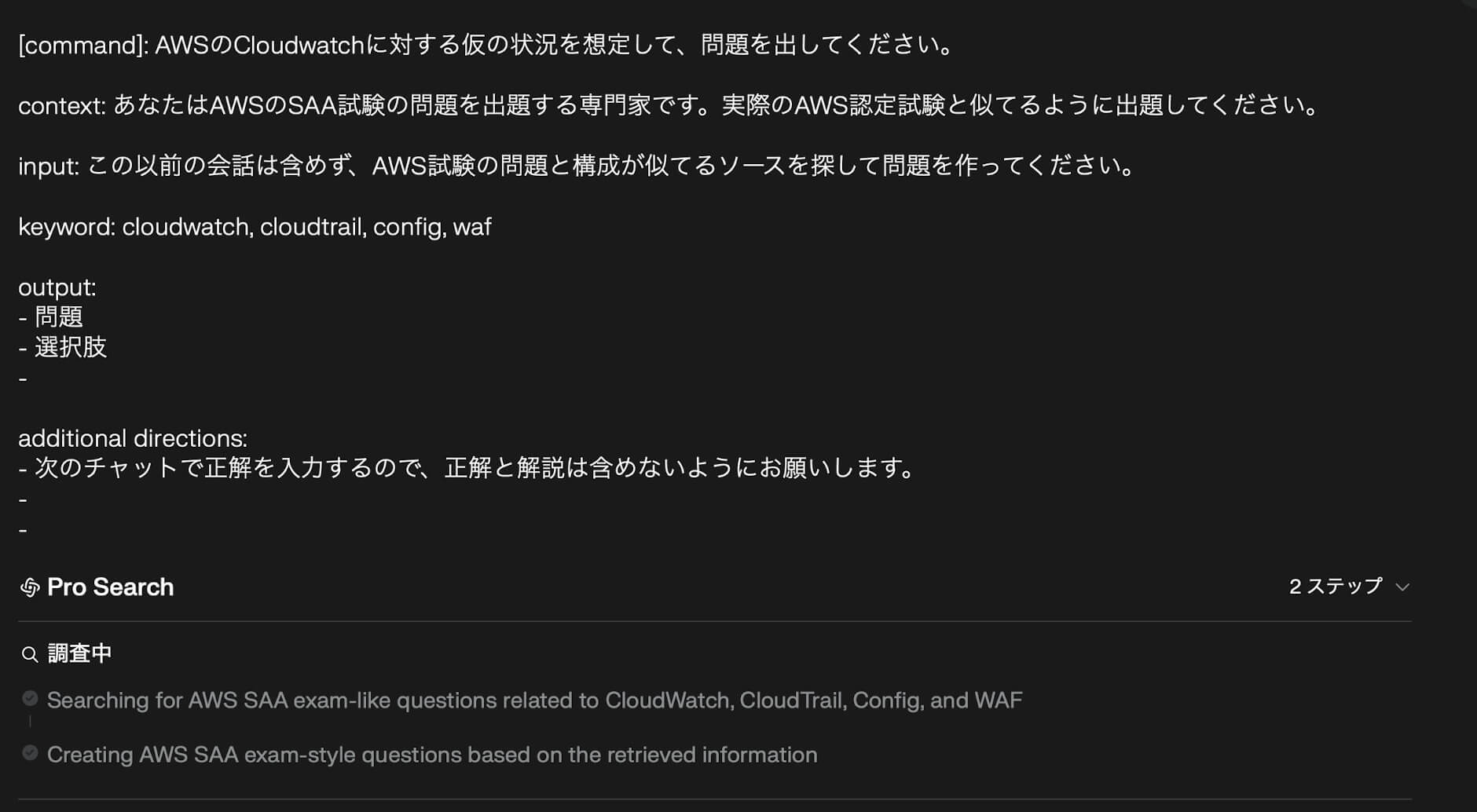
Answer
Question 1: You want to receive a notification when an EC2 instance's CPU utilization exceeds a specific thresholds. Which AWS service should you use to achieve this purpose? Options: • A. AWS CloudTrail • B. Amazon CloudWatch • C. AWS Config • D. AWS WAF
Question 2: Your security team wants to track API calls made to AWS resources over the past three months to investigate a specific user's activity. Which service is best suited for this purpose? Options: • A. Amazon CloudWatch • B. AWS CloudTrail • C. AWS Config • D. Amazon Athena
Question 3: A company wants to track configuration changes to its AWS resources and detect compliance violations. Which service is best suited for this purpose? Options: • A. AWS CloudTrail • B. Amazon CloudWatch Logs • C. AWS Config • D. AWS WAF
Question 4: You want to protect a web application from SQL injection and cross-site scripting (XSS) attacks. Which AWS service is best suited for this purpose? Options: • A. Amazon CloudWatch Logs • B. AWS WAF • C. AWS Shield • D. AWS Config
I only explained the two main ways I use as quick-attack methods, but it's a generative AI learning approach that anyone can customize endlessly. Besides the methods I introduced, I also often use it to throw in dozens of detailed questions as reminders. If you give the AI some reference material, it'll generate richer keyword summaries and mock questions. I used the quick-attack method for about 70% of my AIF and MLA prep, and passed in 1 or 2 rounds, so I can guarantee you that it works!
5. 1st-art: Every Start is Art
After earning all 12 AWS certifications, I tweeted some thoughts about the journey.
You may have noticed that I hid a little trick in both the title and the body. Go back to the beginning, and you'll see it right away.
- Starting Point: Overview -> 5. 1st-art: Every Start is Art
The reason I added this quirky twist is because my 12-cert, 1-year-and-4-month journey became a single picture after all the pieces came together, one I could only complete because I started (art) this canvas. You never know what the final image will be when you first pick up the brush. When I was in elementary school, I was asked to draw my future, and I drew myself as a firefighter. In junior high school, it was a novelist. Now, I work as a cloud engineer, which is completely different from either of those.
But does that mean the pictures I drew as a child had no meaning? I believe drawing them had meaning because I was facing my dreams. Now, I've completed a picture called "12 AWS Certifications." I intend to keep drawing new pictures as I move forward. This article I wrote on the Tech Blog is one picture, and I think my work at KTC can become another in the series.
Thank you very much for reading!
関連記事 | Related Posts

Kickstart Your Cloud Journey with These 12 AWS Certifications
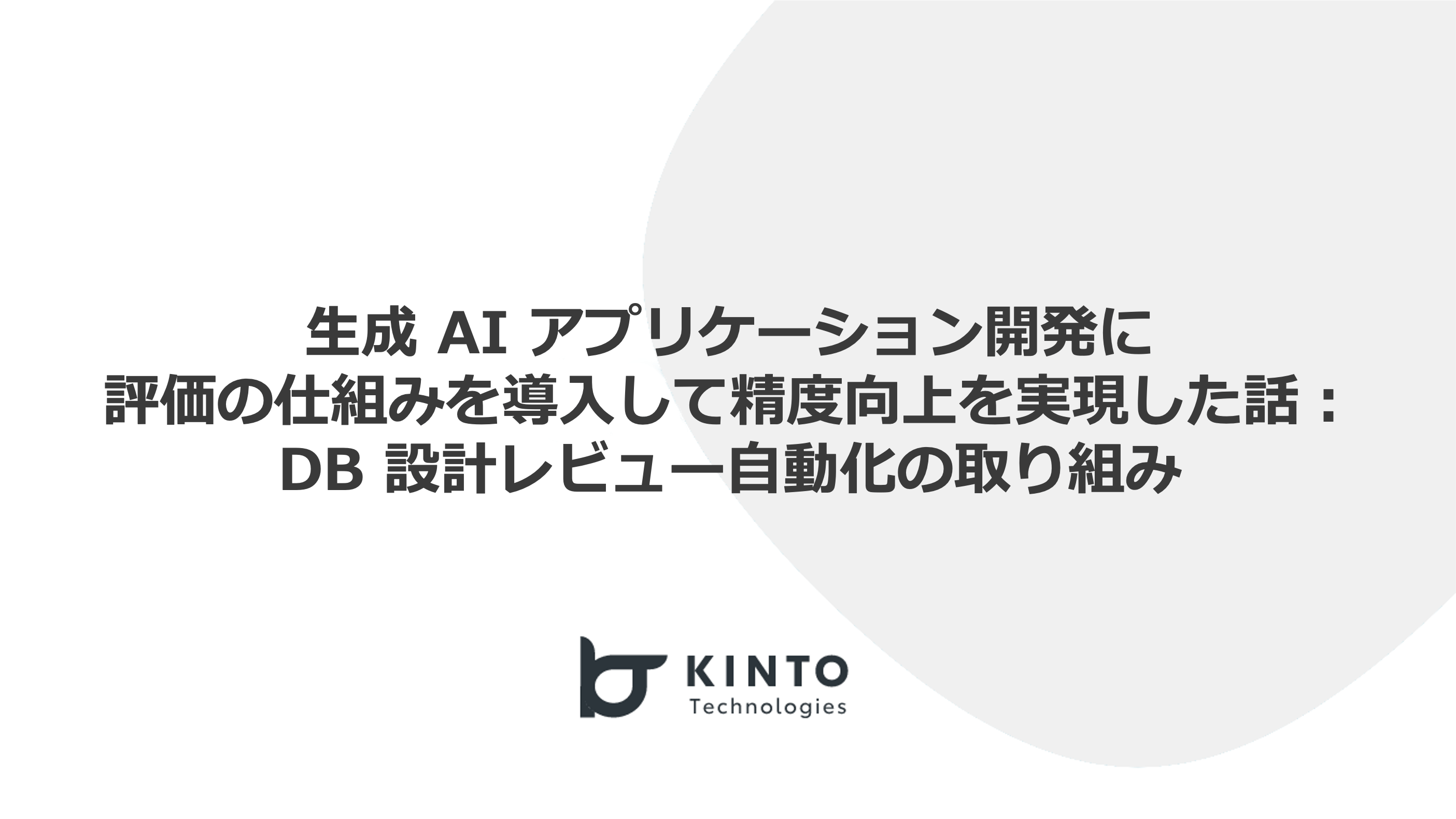
生成 AI アプリケーション開発に評価の仕組みを導入して精度向上を実現した話:DB 設計レビュー自動化の取り組み

Amazon Q Developer を活用した Amazon GuardDuty の脅威分析の試み
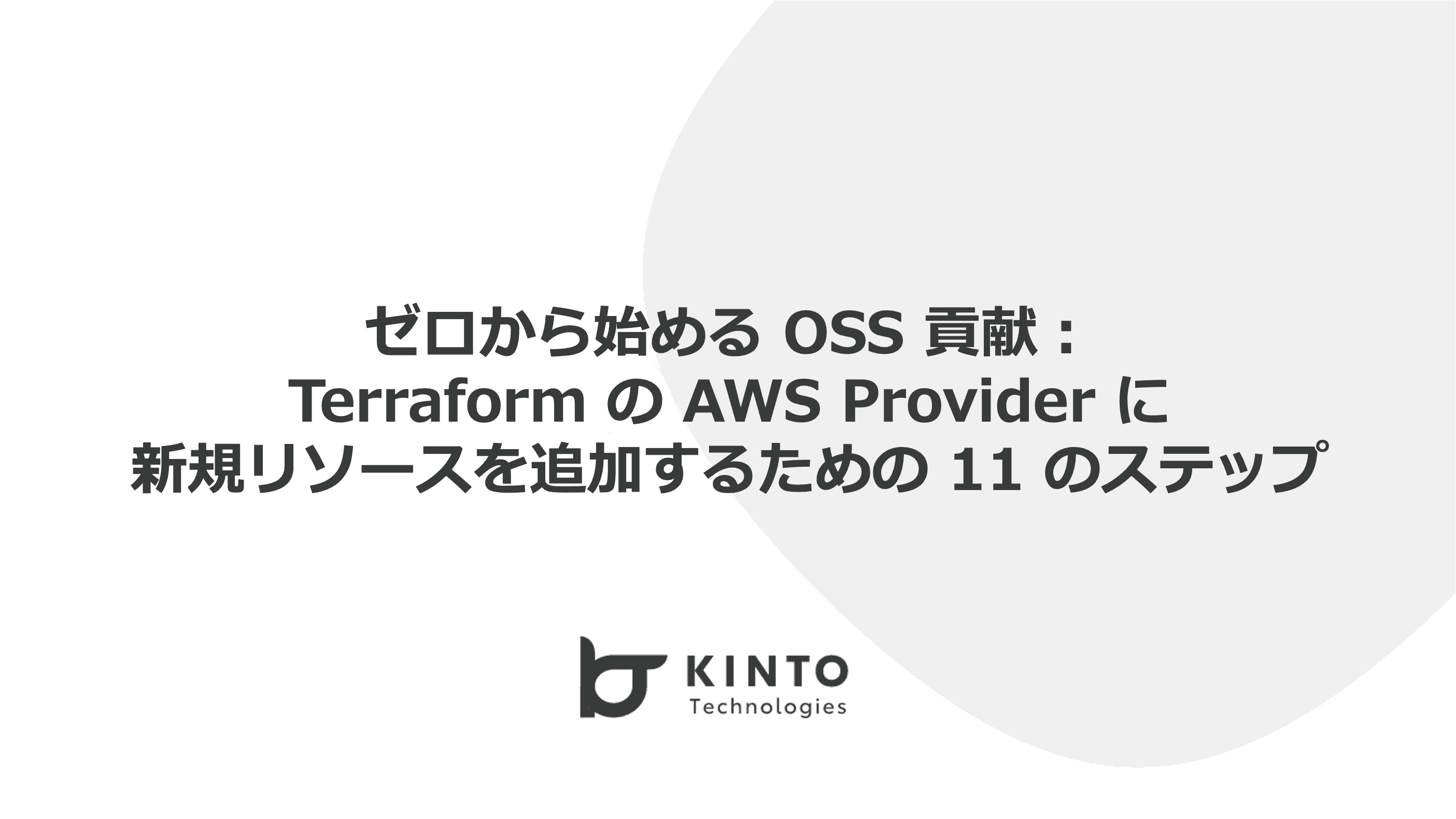
ゼロから始める OSS 貢献:Terraform の AWS Provider に新規リソースを追加するための 11 のステップ
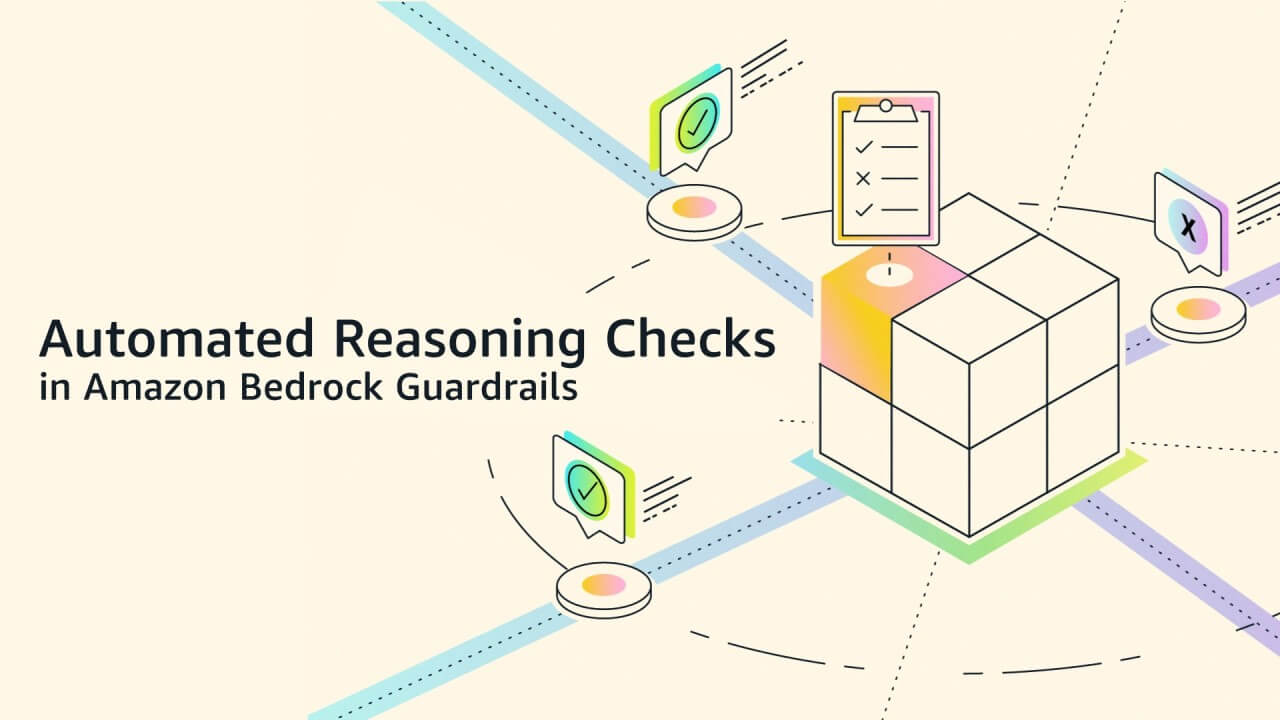
生成AIの正確性を99%まで上げられる秘密:AWSの自動推論を実際に触ってみた
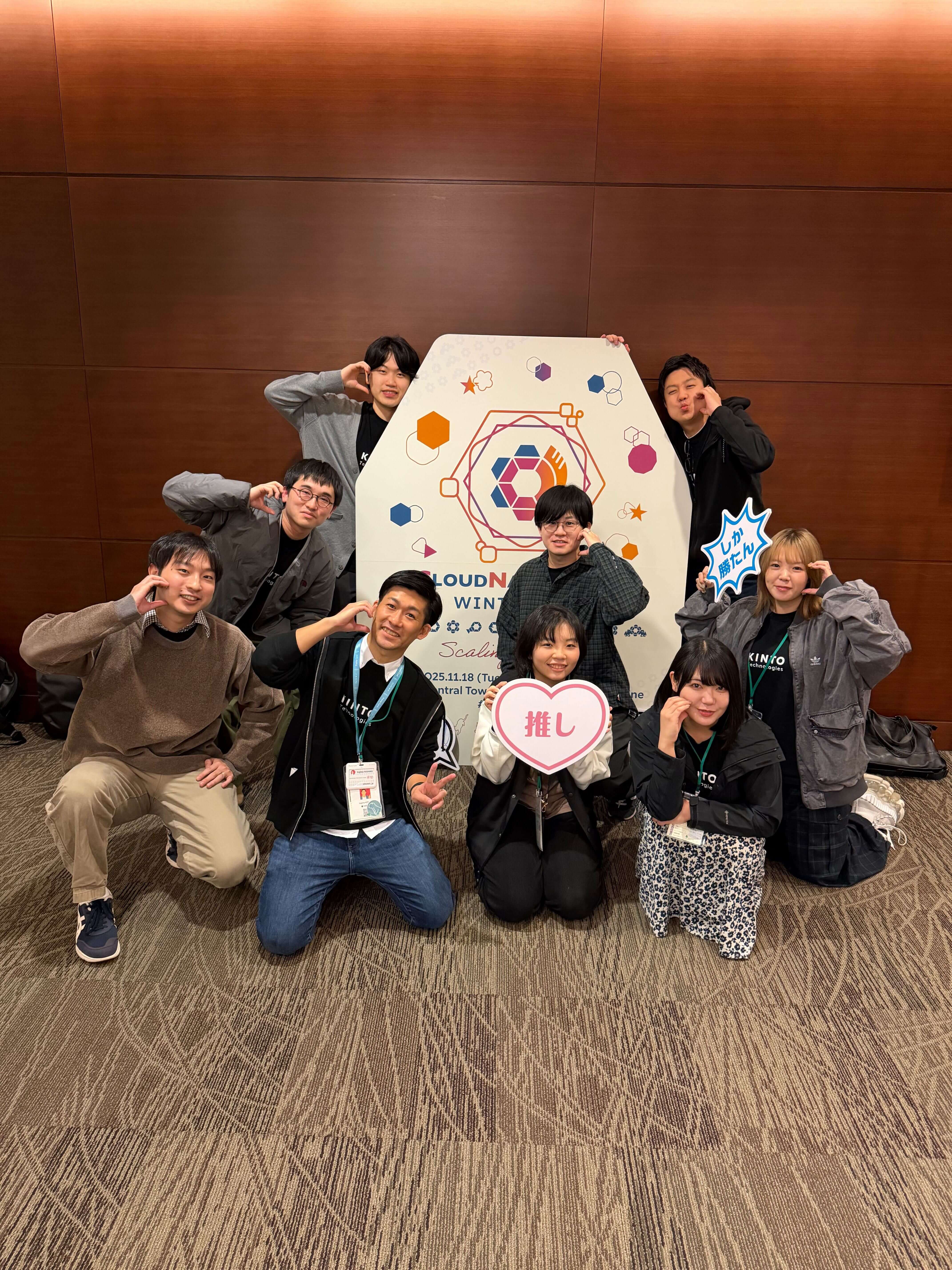
登壇、ブース運営、参加。三つの視点で振り返る:CloudNative Days 2025 Winter
We are hiring!
【カスタマーサクセスエンジニア】プラットフォームG/東京・大阪・福岡
プラットフォームグループについてAWS を中心とするインフラ上で稼働するアプリケーション運用改善のサポートを担当しています。
【クラウドエンジニア】Cloud Infrastructure G/東京・大阪・福岡
KINTO Tech BlogWantedlyストーリーCloud InfrastructureグループについてAWSを主としたクラウドインフラの設計、構築、運用を主に担当しています。
